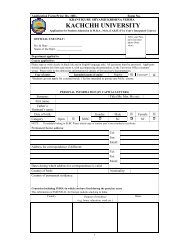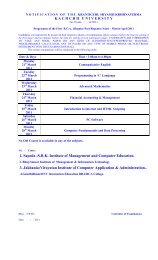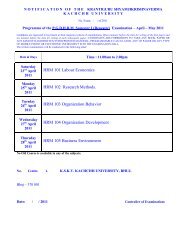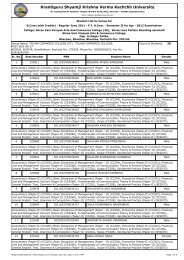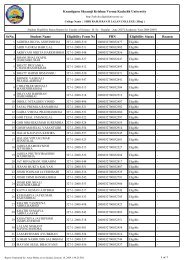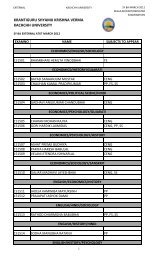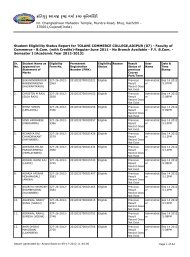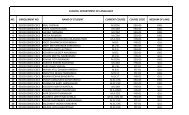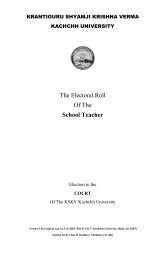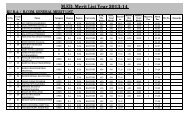Third Year B.Sc. Chemistry
Third Year B.Sc. Chemistry
Third Year B.Sc. Chemistry
Create successful ePaper yourself
Turn your PDF publications into a flip-book with our unique Google optimized e-Paper software.
SYLLABUS1With Effect from June 2009THIRD YEAR B.<strong>Sc</strong>CHEMISTRYKrantiguru Shyamji Krishna VermaKachchh UniversityMundra RoadBHUJ-370 001
2KSKV KUTCH UNIVERSITY : BHUJ : 370 001SYLLABUS OF CHEMISTRYTHIRD YEAR B. <strong>Sc</strong> : In force from June -2009<strong>Chemistry</strong> Paper : VI ( Structural <strong>Chemistry</strong>): Max. Marks : 60UNIT I Symmetry ( 12 M )Symmetry Operations and Symmetry elements ( Cn, σ , Sn, i ) , Multiplication TableC 2 V, C 2 h and C 3 V point groups,Classification of <strong>Sc</strong>hoenflies Point groups : C 1 , Cs, C i , Cn, C nh, Cnv, Dn, Dnh, Dnd,Td and Oh , Matrix representation of Cnz, σ, Sn, i , ESymmetry and Dipole moment, Symmetry and Optical activity.Ref books(1) Physical <strong>Chemistry</strong> by Daniels and Alberty, 4 th Ed , pages 434-446(2) Chemical Applications of Group theory by F A Cotton , 2 nd Ed, pages 14-32 , 33-38 ,45-52 , 62-73.(3) Introductory Quantum <strong>Chemistry</strong> : A K Chandra , 3 rd Ed , page 252-273(4) Chemical Bonding : An Introduction : A K Raval , KC Patel, & R D Patel :2 nd Ed ,Pages 149-189UNIT :II(A) Term symbols ( 6 M )Russel Saunders Coupling and determination of Term symbols in Ground state ,Pigeon hole diagram of p 2 and d 2 , Hund’s rules, Hole formalism, Calculation of numberof microstates.Ref books :(1) Concise Inorganic <strong>Chemistry</strong> : J D Lee , 4 th Ed, pages 938 to 950(B) Electronic Spectra of Metal Complexes : ( 6 M )Electronic Spectra of Transition metal complexes, Selection rules, Laporte OrbitalSelection rules, Spin selection rule, Orgel combined energy level diagram ( d 1 - d 9 , d 2 - d 8only ) and their spectra, Spectra of d 5 , Jahn Teller distortions, Spectro chemical series ,Vibronic coupling.Ref books :Concise Inorganic <strong>Chemistry</strong> : J D Lee , 4 th Ed, pages 951 to 967UNIT : III(A) Mossbauer Spectroscopy : ( 6 M )Principle, Experimental technique and applicationsRef Books:(1) Physical Methods in Inorganic <strong>Chemistry</strong>: R S Drago, pages : 362 – 372(2) Basic principles of Spectroscopy: R Chang: page 90 – 103
(3) Fundamentals of Spectroscopy: C N Banwell, Reprint. Pages 313 – 3233(B) IR and Raman Spectra of Inorganic molecules : ( 6 M )IR Spectra : Basic principle, Instrumentation, Applications of IR spectra in structuraldetermination of simple diatomic and tri atomic molecules like HCl, H 2 O, CO 2 , SO 2NO 2 and Cl 2 ORaman Spectra : Basic , Instrumentation, Applications , Comparison of IR withRaman spectra.Ref Books :(1) Basic Principles of Spectroscopy : R Chang , pages : 149 – 167 , 182- 185(2) Physical methods in Inorganic <strong>Chemistry</strong> : R S Drago(3) Fundamentals of Molecular spectroscopy : C N BanwellUNIT : IV : Spectroscopy for Organic Molecules :(A) Infra Red Spectroscopy : ( 6 M )Introduction, Various types of vibrations, Sample preparation, Group frequencies,Applications in Structural determination including H-bond, tautomers, and geometricalisomers , Finger print region, Examples .(B) NMR Spectroscopy : ( 6 M )Principle , Equivalent and non-equivalent protons, Chemical shift and factorsaffecting it, Relative intensity of signals, Spin-spin coupling, Long range coupling,coupling constant, Deuterium labeling , Application including determination ofAromatic Character, Carbocation , Examples .UNIT : V :Problems based on combined applications of UV, NMR and IR spectroscopy:Reference Books for Units: IV and V :( 12 M )(1) Applications of Absorption Spectroscopy of Organic Compounds : J R Dyer(2) Organic <strong>Chemistry</strong> : VI th Ed, Morrison and Boyd(3) Spectro photometric Identification of Organic Compounds : R M Silverstein , G CBassler & T C Morrill : 4 th Ed. John Wiley & Sons(4) Spectroscopy of Organic Compounds : P S Kalsi : 6 th Ed, New Age InternationalOrganic Spectroscopy : William Kemp, 2 nd Ed, ELBS(5) Elementary Organic Absorption Spectroscopy : Y R Sharma & O P Vig . S.Chand& company, New Delhi==============================================================
T. Y. B . <strong>Sc</strong> : CHEMISTRY : VII (Inorganic <strong>Chemistry</strong>) M. M. : 60UNIT : I : Quantum <strong>Chemistry</strong> : ( 12 M )Setting up of Operators for observables, Time – dependant <strong>Sc</strong>hrodinger waveequation, Elimination of Time part, Stationary states, Important theorems concerningHermitian operators, Particle in a three dimensional box, Separation of variables, Eigenfunctions and Eigen values, Symmetry and degeneracy.Electron in a ring, Rigid rotator problem, Application to rotation spectra of diatomicmolecules, <strong>Sc</strong>hrodinger equation in spherical polar co-ordinates for hydrogen atom,Separation of variables, solution of φ and Φ equation, Total energy of Hydrogen atom asper the variation method and the secular equation.4Ref. Books :(1) Introductory Quantum <strong>Chemistry</strong> : A K Chandra(2) Quantum mechanics in <strong>Chemistry</strong> : Melvin W Hanne(3) Chemical Bonding : An Introduction : A K Raval , K C Patel, & R D Patel(4) Theoretical Inorganic <strong>Chemistry</strong> : Dey & SelbinUNIT : II : Chemical Bonding :(A) Valence Bond treatment of H 2 and H 2+ ion , Comparison of VB and MO for thesemolecules, Molecular orbital treatment for square planar, tetrahedral complexes,Molecular orbital treatment of polyatomic molecules such as BeCl 2 , BeH 2 , BH 3 , CH 4 ,H 2 O and NH 3 ( 6 M )(B) Three centered bonds in B 2 H 6 and structure of Boranes , MO treatment forcomplexes such as [ Pt Cl 4 ] -2 , [NiF 4 ] -2 , [IrF 6 ] -4 , [Fe(CN) 6 ] -4 , [FeF 6 ] -3 , [V(CN) 6 ] -3Simple Huckel theory , Basic concept of pi electron approximation ( 6 M )Ref. Books:(1) Electron and Chemical Bonding : Harry B Grey(2) Valency and Molecular structure : E Cartmell and G W Fowels(3) Advanced Inorganic <strong>Chemistry</strong> : F A Cotton, and Wilkinson.UNIT : III(A) Coordination <strong>Chemistry</strong> : (6 M)Reaction Kinetics, and mechanism, Trans effect and Trans influence, itsapplication in synthesis, Mechanism of trans effect, Lability, Inertness, Stability andinstability(B) Kinetics and Reaction rates of Substitution : ( 6 M )Ligands field effect and reaction rates, Mechanism of substitution reaction,Substitution in Octahedral complexes, Substitution reaction in square planar complexes,Substitution in square planar Pt(II) complexes, substitution in Octahedral Co(III)complexes, [Cis-effect ] Associative , Dissociative and SN-1 mechanism.Ref Books:
(1) Inorganic <strong>Chemistry</strong> : James E Huheey(2) Mechanism of Inorganic Reactions : Basolo & PearsonUNIT : IV(A) Metal Carbonyls : ( 4 M )Mono and poly nuclear metal carbonyls such as Ni(CO) 4 , Fe(CO) 5 , Cr(CO) 6 ,Fe 3 (CO) 12 , Co 2 (CO) 8 , Mn 2 (CO) 10 , Ir 4 (CO) 12Metal Nitrosyl and Metal Carbonyl hydrides, Application of IR spectra in thestructure determination of metal carbonyls.Ref Books :(1) Advanced Inorganic <strong>Chemistry</strong>: Cotton & Wilkinson, 3 rd ED, pages 683-698,702- 706, 713-715(2) Inorganic <strong>Chemistry</strong>: James E Huheey(3) Introduction to Advanced Inorganic <strong>Chemistry</strong> : Durrant & Durranr(B) Magneto <strong>Chemistry</strong> and SHAB : ( 4 M )Types of magnetic behaviour, Methods of determining magnetic susceptibility, Spin onlyformula, Correlation of μs and μeff values ; Hard –Soft Acids & Bases(C) Organometallic Compounds : ( 4 M )Definition, , Classification, Synthesis ( General methods), Properties and structureandapplication of Organo metallic compounds of Mg , Al and Be; OMC of firsttransitionseries elements.Ref Books :(1) Basic Inorganic <strong>Chemistry</strong> : F A Cotton & G WilkinsonUNIT : V Industrial <strong>Chemistry</strong> :(A) Ceramic Industries : ( 4 M )Classification of Ceramic products, Basic raw material in ceramic industries,fluxing agents, Glazing Porcelain(B) BIO INORGANIC CHEMISTRY : ( 5 M )Role of Myoglobin and Hemoglobin in biological system, cooperative effect.Metallo enzymes, Inhabitation and poisoning of enzymes, Role of alkali and alkalineearth metal ions in biological systems, Sodium pump, Calcium pump, Biological junctionand toxicity of some elements, Biological fixation of nitrogen.(C) Generation of Electricity from Nuclear Energy , Its merits and demerits,Hydrogen energy ( 3 M )5==============================================================
T. Y. B . <strong>Sc</strong> : CHEMISTRY : VIII (organic <strong>Chemistry</strong>) M. M. : 60UNIT:I(A) Stereo <strong>Chemistry</strong> : ( 6 M )# Molecular asymmetry of Di phenyls , Allenes and Spiranes .# Stereo selective and stereo specific reactions : Stereo chemistry of addition of halogensto alkenes. Syn and anti addition .Ref :Organic <strong>Chemistry</strong> : VI th ed , R T Morrison and R N Boyd , pages 367 - 376 .# Concept of pro-stereoisomerism and Chiral synthesis : Cram’s Rule, Prelog’s Rule andassignment of configuration.Ref : Stereochemistry : Configuration and Mechanism : P.S.Kalsi; Wiley Eastern Ltd.( B ) Name –reactions / rearrangements ( 6 M )Principle, Mechanism and synthetic applications of these reactions :(1) Pinacol-pinacolone rearrangement (2) Fries Migration (3) Hofmann reaction(4)Dakin Reaction (5) Diels-Alder reaction (6) Benzil-Benzilic acid rearrangement (7)Curtius rearrangement6UNIT:II:(A) Nucleophilic reactions (Aliphatic): ( 4 M )Definition, types of reactions , discusstion about SN-1 and SN-2 reaction(definition,mechanism, evidences, stereochemistry, graph etc ) , Factors affecting thecourse and mode of SN reactions ( Nature / structure of Substrate, nature of Nucleophile,Nature of leaving group, nature of solvent ) ,Neighboring group participation , SN-ireaction, Walden inversion.Ref: Org. Chem. 3 rd Ed : James B Hendrickson, Donald J Cram, George S HammondChapter 10, page 375 -(B) Elimination reactions: ( 4 M )Definition, classification, discussion about E-1, E-2 and E-1CB mechanism,Carbonium ion rearrangement, Orientation of double bond in elimination reactions.Ref : Org. Chem. 3 rd Ed : James B Hendrickson, Donald J Cram, George S Hammond(C) Nucleophilic Aromatic substitution: ( 4 M )Definition, Bimolecular displacement and its mechanism, reactivity, Orientation,Electron withdrawal by resonance, Evidence for two step mechanism, BenzyneMechanism including structure of Benzyne and evidences.Ref: Organic <strong>Chemistry</strong>: VI th ed , R T Morrison and R N Boyd , sec 26.1, 26.4 to 26.14UNIT: III(A) Isoprenoids ( Terpenoids) : ( 6 M )Classification, general methods of determining structure of isoprenoids, Isoprene rules,<strong>Chemistry</strong> of Citral , α-Terpineol and Camphor with their synthesis , study of reactionsof β-carotene ( No synthesis )
7Ref : Organic <strong>Chemistry</strong> : I L FinarAR , Vol.II , 5 th Ed, pages 354-358, 361-365, 369-371, 392-395.(B) Alkaloids : ( 6 M )Classification, Definition, General methods of determining structure, Structure ofConiine, Nicotine and Atropine including their synthesis.Ref : Organic <strong>Chemistry</strong> : I L Finar, Vol.II, 5 th Ed, pages 696-702, 713, 717-726UNIT : IV(A) Carbohyddrates : ( 6 M )Disaccharides: Structure of Maltose, Cellobiose, Lactose and SucroseRef: Organic <strong>Chemistry</strong>: VI th ed , R T Morrison and R N Boyd , pages 1185-1192(B) Heterocyclic compounds: ( 6 M )Structure and aromaticity of Pyrrole, Furan and Thiophene, Electrophilicsubstitution reactions, Reactivity and Orientation, Structure of and aromaticcharacteristics of Pyridine, SE and SN reactions of Pyridine, Basicity of Pyridine,Synthesis and reactions of Quinoline and Isoquinoline, Synthesis of Pyrimidine, Uracil,Thymine and Cytosine.UNIT : V( A ) Synthetic Perfumes : (5M )Definition, Vehicle, Fixative, Odorous substances, Classification, Synthesis of (1) Methylanthranilate (2) Phenyl alcohol (3) Linalool (4) Musk Ketone (5) α and β –Ionones (6)VanillineRef: Synthetic Organic <strong>Chemistry</strong>: O.P.Agarwal(B) Synthetic Drugs : ( 7 M )Chemotherapy, Brief notes on Antipyretics, Analgesics, Hypnotics, Sedatives,Anesthetics, Antimalerials, Antiseptics, Tranquilizers, Cardiovascular drugs withminimum of two examples with structural formula from each family.Synthesis and use of (1) Sulphathiazole (2) Sulphadiazine (3) Paracetamole (4)Benzocaine (5) Para amino salicylic acid ( PAS) (6) Phenacetin (7) Antipyrine (8)Tolbutamide (9) Chloramine-T (10) n-Hexyl resorcinol.Ref : (1) A text book of Pharmaceutical <strong>Chemistry</strong> –II : Dr. A V Kasture & Dr. S GWadodkar : Nirali Prakashan (2) Organic Pharmaceutical <strong>Chemistry</strong> : Harkishan Singh &V K Kapoor : Vallabh Prakashan, Delhi=====================================================
T. Y. B . <strong>Sc</strong> : CHEMISTRY : IX ( Physical <strong>Chemistry</strong> ) M. M. : 60UNIT : I : Thermodynamics : ( 12 M )Zeroth law of TD, Difference between heat and temperature, Thermometricequation, Clausius-Clapeyron equation and its application, Trouton’s law, Craft’sequation, Colligative properties, Elevation in boiling point, Depression in freezing point,van’t Hoff’s isotherm, van’t Hoff’s isochore, <strong>Third</strong> law of TD, Chemical potential,Derivation of Law of mass action using Chemical potentialUNIT : II : Electrochemistry : ( 12 M )* Reversible cells and reversible electrodes, Electrical double charge layer andelectrode potential, Nernst equation,*Electrodes reversible with respect to cations, Electrodes reversible with respectto anions, Metal insoluble salt electrodes, Oxidation-reduction electrodes, Referenceelectrodes, Hydrogen electrode, Calomel electrode, Quinhydron electrode, Glasselectrode,*Measurement of emf by Poggendroff’s method, Weston cell, concentration cells,Types of concentration cells, Derivation of equation of emf of each concentration cell,Derivation of equation of emf of concentration cell with transference and withouttransference, LJP and derivation of equation of emf of LJP, Application of emfmeasurement in determination of solubility and solubility product of sparingly solublesalt, ionic product of water, pH, thermodynamic function of G, S, H K , Valency ofcations, transference number, Instability constant of complex ion, degree of hydrolysis ofa salt,*Decomposition potential, its experimental determination, Application ofdecomposition potential, Over voltage, Types of over voltage, factors affecting overvoltage , its application.8UNIT : III:(A) Chemical Kinetics : ( 4 M )Activated complex theory, Predictions of reaction rates , Salt effect, Primary andsecondary salt effect, Heterogeneous gas reaction, Retardation reaction.(B) Polymer <strong>Chemistry</strong> : ( 4 M )Mol Wt. ( Mn and Mw) , Degree of polymerization, Classification of polymers,Determination of molecular weight by osmotic pressure method, viscosity method, lightscattering method, sedimentation method, Flory Huggin’s theory, Dissolution of polymerand thermodynamics of polymer solution(C ) Phase rule : ( 4 M )Derivation of phase rule, condensed phase rule equation, study of twocomponents systems, Pb / Ag system, Zn / Cd system, Zeotropic and azeotropicmixtures, Phenol – water , Triethylamine-water and Nicotine-water systems, Fractionaldistillation and steam distillation.
UNIT : IV(A) Nuclear <strong>Chemistry</strong> : ( 4 M )Detection of isotopes, Velocity focusing mass spectrograph, ( Banbridge), Directionfocusing mass spectro meter ( Dempster), Double focusing mass spectrometer ( Nier) ,Separation of isotopes: Gaseous diffusion method, Thermal diffusion method, Massspectrograph method, Laser technique, Applications of isotopes, Tracer technique,Artificial Nuclear reactions, Types of Nuclear reactions , Artificial and inducedradioactivity, Energy changes in nuclear reactions, Nuclear Fission and nuclear fusion,Units used in nuclear science: Curie, Rutherford, Becquerel, Barn, Fermi, Gray , Sievert.(B) Molecular Spectra : ( 4 M )Pure rotational spectra, Vibrational - rotational spectra, Raman spectra, Electronicspectra, Morse energy curve and ortho & para Hydrogen.(C) Photochemistry ( 4 M )Laws of photochemistry, Grotthuss-Draper law, Stark-Einstein law, Quantumyield, High quantum yield , Low quantum yield, Experimental determination of quantumyield, Types of photochemical reactions, Fluorescence and Phosphorescence,Chemiluminescence Photosensitization, Flash Photolysis, Photo stationary state, Blackwhiteand colored photography.9UNIT: V : Industrial <strong>Chemistry</strong> : (12 M)(A) Desalination or Reverse osmosis(B) Electrochemistry and pollution control(C) Fuel cell :Gemini cell, Bacon cell, Electrodes and Electrolytes used in fuel cell, Classificationbased on temperature, Efficiency of fuel cell, Hydrocarbon fuel cell, Methanol fuel cell,Hydrazine fuel cell, Air depolarized cell, Use of porous electrodes in fuel cell,Electrochemistry of fuel cell.(D) Metallic corrosion :Types of corrosion, Electrochemical series, Differential aeration principle,Corrosion in acidic medium, Corrosion in neutral medium, Prevention of corrosion byvarious methods, Polarization and types of polarization, Factors affecting corrosion,Atmospheric corrosion, Effect of moisture and pollutants on corrosion rate.(E) Anodic/ cathodic technical reactions :Current efficiency, Energy efficiency, Advantages of electro-chemical methods,Electrolysis of NaCl in different conditions, Electroplating and production of metalpowder, Preparation of organic compounds: Alkane, Anthraquinone, Aniline, Sorbitol,Mannitol, Preparation of Inorganic compounds : KMnO 4 , K 2 S 2 O 8 , K 3 [Fe(CN) 6 ], H 2 O 2 .===============================================================
T. Y. B. <strong>Sc</strong>: CHEMISTRY: X (Analytical <strong>Chemistry</strong>) M. M. : 60UNIT : I :(A) Treatment of analytical data : (4 M)Significant figures, Accuracy, Precision, Types of errors and minimization of oferrors, Ways of expressing accuracy and precision, rejection of result, Test ofsignificance ( Q. test, students t-test and F-test), Correlation coefficient.10(B) Theory of precipitation:(4M)Formation of precipitates, Particle size of precipitates, Impurities in precipitates,Purification of precipitates, Precipitation from homogeneous solution, Precipitationtitrimetry, Mohr’s method, Volhard method , Fajan method, construction of titrationcurve, Factors influencing the sharpness of end point(C) Solvent Extraction : ( 4M )Distribution coefficient, Distribution ratio, Solvent extraction of metals,Extraction process, Separation efficiency, Choice of solvent.UNIT: II(B) Redox Titrations:(6M)Calculation of potential at various point on the titration curve, Redox indicators,Potential requirements of oxidation reduction titrations, Multicomponent titrations,Iodometry and Iodimetry , Metal reductors.(C) Potentiometry :(6M)The scope of potentiometric titrations, Precipitation and neutralization titrations,Graphical methods including Gran’s plot for selecting end point, Differential titrations,Dead stop titrations, Ion selective electrodes, Types of ion selective electrode, workingand use of Calcium ion selective electrode, Principle of pH meter.UNIT : III(A) Polarography : ( 4 M )Principle, Electrodes, Types of current, Half wave potential, Ilkovik equation,Method of determining concentration.(B) Colorimetry and Spectrophotometry : ( 4 M )Laws of absorption, Spectrophotometric instrument, Light sources, Opticalsystem, Wavelength selector, Light sensitive devices, Accuracy and error ofspectrophotometry, Analysis of mixtures.(C) Flame Photometry : ( 4 M )
11Flame emission spectroscopy, and Atomic absorption spectroscopy, Principleand comparison, Inductively coupled plasma emission spectroscopy, Burners (Totalconsumption burner and pre mix burners )UNIT : IV(A) Acid – Base titrations ( 6 M)Titrations of polyprotic acids, and mixture of acids, Titration of salts, Differentialalkali titrations, Buffer solution, Buffer level, Buffer range, Buffer efficiency, Buffercapacity.(B) Complexometric titration : ( 6 M )Types of titrations, Different indicators, pH effect, Hydrolysis effect, Ligand effect,Masking & demasking, construction of titration curveUNIT : V(A) Chromatography : ( 4 M )Adsorption chromatography, Paper chromatography, Thin Layer chromatography, Ionexchange chromatography, Gas chromatography, Instrumentation and evaluation of data,High performance liquid chromatography ( HPLC-Principle only)(B) Ion exchange resin : ( 4 M )Ion exchange equilibrium, Types of ion exchange resins, Ion exchange capacity,Applications of Ion exchange resins.(C) Types of Analytical methods : ( 4 M )Introduction, Branches of <strong>Chemistry</strong> , Analytical <strong>Chemistry</strong>, Importance ofAnalytical <strong>Chemistry</strong>, Classification of Analytical methods, Advantages and limitationsof Chemical methods and Instrumental methods, Literature of Analytical <strong>Chemistry</strong>including Chemical abstract , Names of few reference books and Journals on Analytical<strong>Chemistry</strong>Ref Books :(1) Instrumental Methods of Chemical Analysis : B K Sharma : Goel Publishing House,Merrut (2) Quantitative Analysis : Day and Underwood (3) Fundamentals of Analytical<strong>Chemistry</strong> : Skoog and West (4) Analytical <strong>Chemistry</strong> : IV th Ed. Gary D Christian .
Kachchh University , BHUJT .Y. B. <strong>Sc</strong>: PRACTICALS IN CHEMISTRY(A) Organic Separation and organic spotting :Binary Organic Mixture , Separation of two components from the mixture . Watersoluble compound included. Identification of both of the components by Lassign test,Physical & Chemical methods, determination of MP/BP and preparation of derivative ofany one compound of the mixture. Minimum of eight solid mixtures and three liquidmixtures to be done.Chemical compounds :Solids : Benzoic acid , Cinnamic acid, Salicylic acid, Phthalic acid, α-Naphthol, β-Naphthol, α- Naphthyl amine, p-Toluidine, meta and para- Nitro anilines, Diphenylamine, m-Dinitrobenzene, Acetanilide, Naphthalene, Anthracene,Water soluble : Succinic acid, Oxalic acid, Tartaric acid, Citric acid, Urea, Thiourea,AcetamideLiquids : Low BP : Acetone, Benzene, Chloroform, Ethyl acetate, Methyl aceate ,Ethanol, Methanol, CTCHigh BP : Nitrobenzene, Aniline , Chloro benzene, Bromo benzeneFew examples of Mixtures :Solids : (1) Benzoic acid + Naphthalene (Type: Acid + Neutral ), (2) Salicylic acid +α-Naphthol ( Acid + Phenol ) ,(3) Succinic acid + m-Dinitrobenzene ( Water soluble acid+ insoluble neutral ) etcLiquid Mix : L + L : Benzene + Aniline , Acetone + Nitrobenzene etcS + L : Benzoic acid + Acetone , Succinic acid + Ethyl acetate etc(B) Organic Preparation :Preparation by single stage method(1) p-Bromo acetanilide from Acetanilide ( Bromination )(2) Tri Bromo aniline from Aniline (Bromination )(3) Tribromo phenol from Phenol (Bromination)(4) p-Nitro acetanilide from Acetanilide (Nitration )(5) m-Dinitrobenzene from Nitrobenzene (Nitration)(6) Benzoic acid from Benzaldehyde (Oxidation)(C) Organic Estimation :(1) To find out Mol. Wt of Organic acid by titrimetry method(2) To find out basicity of organic acid by titrimetry method(3) To find out the purity of the sample of organic acid(4) To find out the amount of Acetone in the given solution by iodine method(5) To find out amount of Ethyl acetate by hydrolysis method(6) To find out saponification value of an oil.(7) To find out %age purity of Ethyl acetate by hydrolysis method12
(D) Inorganic Qualitative Analysis :Analysis of inorganic mixture containing six radicals only. Minimum of 12 ( Twelve )mixtures to be done and reported in journal . Arsenic element not to be given in anyform. No negative marking for wrong detection of Sodium ion .Examples of some mixtures :(i) FeCl 3 +KNO 2 + NaNO 3 (ii) CuCl 2 + KI + CdCO 3(E) Inorganic Gravimetric :Gravimetric determination of the metal after removing one impurity metal(1) BaCl 2 +FeCl 3 +HCl ( Estimation of Ba as BaSO 4 , after removal of Iron )(2) MnCl 2 + CuCl 2 + HCl ( Estimation of Mn as Mn 2 P 2 O 7 , after removing Copper )(3) FeSO 4 .(NH 4 ) 2 SO 4 + CuSO 4 + H 2 SO 4 ( Estimation of Iron as Fe 2 O 3 )(4) Al 2 (SO 4 ) 3 + CuSO 4 + H 2 SO 4 ( Estimation of Al as Al 2 O 3 , after removing Copper)(5) Analysis of Brass ( Cu Volumetrically and Zn gravimetrically)(6) Analysis of German Silver ( Cu volumetrically and Ni as Gravimetrically)(F) Inorganic Volumetric analysis :(1) Estimation of Fe +3 by EDTA(2) Determination of Bi +3 by EDTA(3) %age purity of H 2 O 2 by Iodometric method(4) Estimation of Cl -1 by Silver nitrate ( Mohr’s method)(5) Estimation of Zn +2 & Cd +2 in a mixture by Edta(6) Estimation of Ca +2 & Mg +2 in a mixture by Edta(G) Physico-Chemical exercise :Chemical Kinetics :(1) To study reaction between(a) K 2 S 2 O 8 and KI ( a = b )(b) HBrO 3 and KI (a = b ; a ≠ b )(c) H 2 O 2 and HI (a = b ; a ≠ b )(2) To determine the energy of activation and temperature coefficient of hydrolysis ofMethyl acetate or Ethyl acetateConductometry :(1) To titrate the mix of strong acid + weak acid against strong base(2) To titrate the mix of strong base + weak base vs strong acidpH metry :(1) To titrate strong acid against strong base(2) To titrate a mixture of strong acid + weak acid against strong basePotentiometry :(1) To titrate strong acid against strong base(2) To titrate Fe +2 against K 2 C 2 O 7Colorimetry :(1) To study Beer’s law and to determine the concentration of (i) Cu +2 (ii) CrO 4-2(iii) Fe +3 in unknown solution.Distribution law :13
(1) To study the distribution of Ammonia between Water and Chloroform(2) To study the distribution of Ammonia between Water and Carbon tetra chlorideThermo chemistry :To determine the heat of solution of an organic acid ( Benzoic acid, Salicylic acid,Succinic acid )(H) Chromatography :(1) Separation of IInd group ions(2) Separation of Dyes(3) Separation of Amino acids14Distribution of Marks of practical work :Organic separation and spotting : 25Organic estimation OR Organic preparation : 15Inorganic Mixture : 25Inorganic Gravimetric 20Inorganic Volumetric 15Physico chemical exercise : 25Chromatography : 05Viva : ( Pertaining to practicals only ) 10Certified Journals 10Total : ( External practical Marks ) 150Note : Student shall not be allowed to appear for the examination if he /she does not produce the certified journals.
Kachchh University : Question Paper styleTYB<strong>Sc</strong> : CHEMISTRY(1) For every question paper, there shall be FIVE main questions,with internal options.(2) Questions are to designed in such a manner that no topic /chapter is left out untouched. Means all the chapters are to becovered.(3) Every main question must be of 12 marks. (MM = 60)(4) Questions can be of this type depending on the number ofchapters:Q.1 (a), (b) and (c) OR Q.1 (a), (b) and (c) .Q.1 (a) OR (a), (b) OR (b) etc...Q.1 (a) Attempt any TWO out of three or Four(b) Attempt any Two/Three out of three / four / five etc…Similarly other questions are to be set.(5) Proper data / constants are to be given in the paper.(6) Spectral data on NMR and IR are to be given in paper no. VI(Structural <strong>Chemistry</strong>).(7) Numerical problems are to be asked wherever necessary.===================================================15Ramesh LuhanaHoD, <strong>Chemistry</strong>Tolani College of Arts and <strong>Sc</strong>ienceAdipur.Chairman, <strong>Chemistry</strong>Kachchh UniversityBHUJ: Kachchh: 370 201



